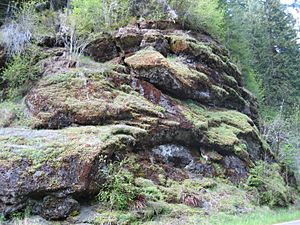Siletz River Volcanics facts for kids
Quick facts for kids Siletz River VolcanicsStratigraphic range: Selandian-Ypresian (Tiffanian-Bridgerian) 59.6–47.6Ma |
|
|---|---|

Exposed pillow lava in the Northern range
|
|
| Type | Formation |
| Underlies | Yamhill Formation |
| Lithology | |
| Primary | Sills of tholeitic to alkalic basalts |
| Other | Tuff-breccia, siltstone, sandstone |
| Location | |
| Coordinates | 44°54′N 123°24′W / 44.9°N 123.4°W |
| Approximate paleocoordinates | 47°00′N 107°30′W / 47.0°N 107.5°W |
| Region | Benton, Coos, Douglas, Lane, Lincoln, Polk, Tillamook, Washington & Yamhill Counties, Oregon |
| Country | |
| Type section | |
| Named for | Siletz River |
The Siletz River Volcanics, located in the Oregon Coast Range, United States, are a sequence of basaltic pillow lavas that make up part of Siletzia. The basaltic pillow lavas originally came from submarine volcanoes that existed during the Eocene.
Description
The Paleocene to Eocene volcanics consist of volcanism flows and sills of tholeitic to alkalic basalts with associated tuff-breccia, siltstone and sandstone. The flows are vesiculated with zeolite filled amygdules.
The volcanics originated as oceanic crust and seamounts. Potassium argon dating gives ages of 58.1 ± 1.5 to 50.7 ± 3.1 Ma; Selandian to Ypresian.
The sequence has been divided into a lower pillowed tholeiitic unit and an upper porphyritic alkali basalt unit.
The volcanics occur in the following counties of western Oregon: Benton, Coos, Douglas, Lane, Lincoln, Polk, Tillamook, Washington and Yamhill.
Fossil content
The sedimentary beds at the Ellendale Basalt and Portland Cement Company Quarries, interbeds in the upper part of the Siletz River volcanics, have provided fossils of the archaeogastropods Pleurotomaria (Entemnotrochus) baldwini, P. (E.) schencki and P. (E.) siletzensis.

